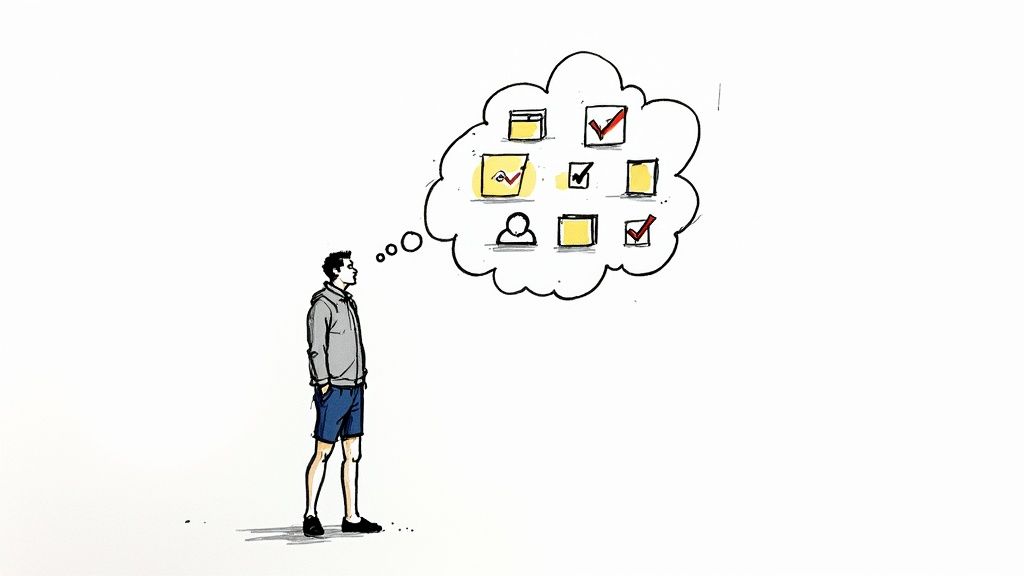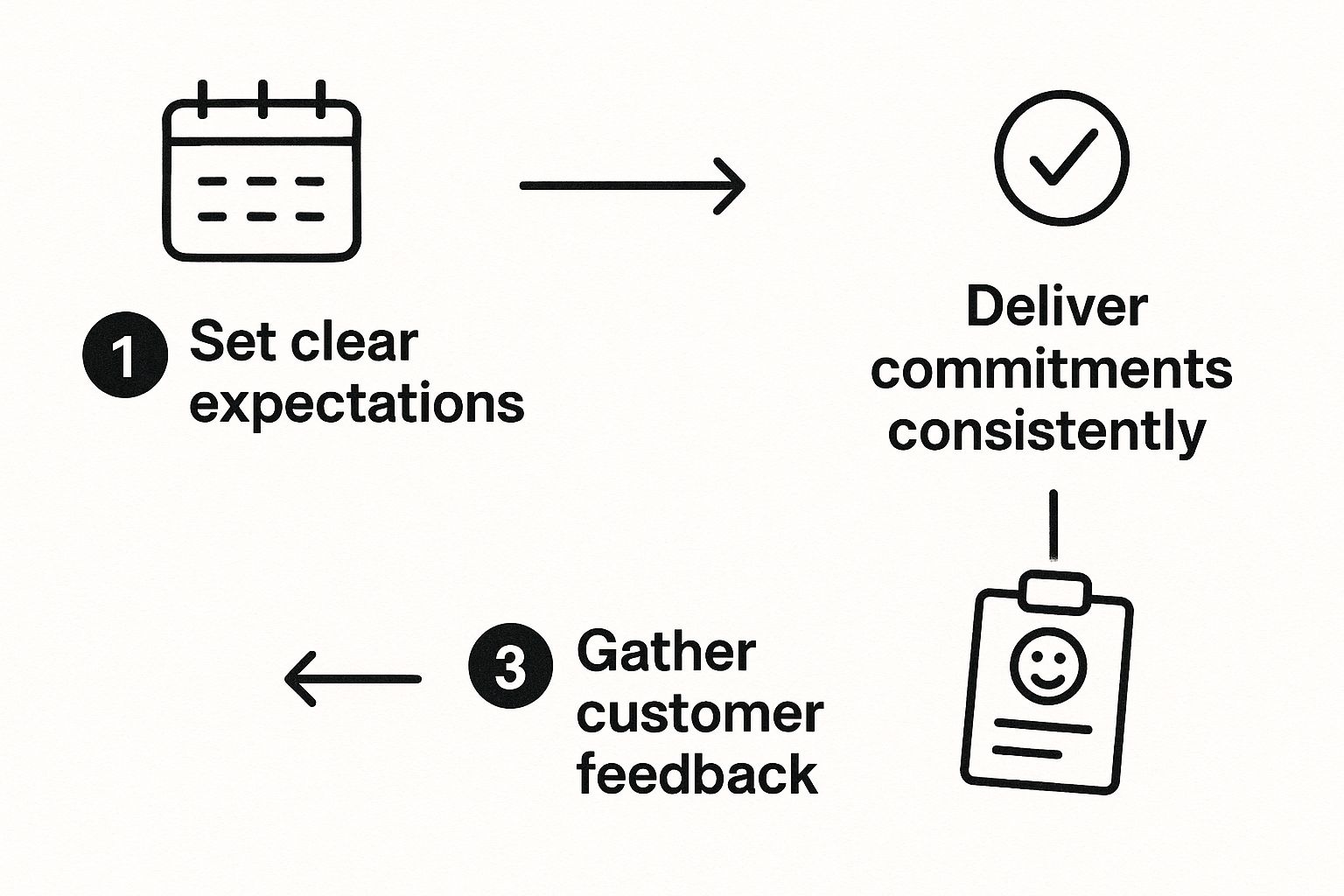Let's be honest: building real rapport with customers isn't about reciting scripts or forcing a smile. It’s about moving past purely transactional conversations and creating a genuine human connection. It means showing you're actually interested in them, you understand their world, and you're someone they can trust right from that first email.
This simple shift is what turns one-time buyers into your most vocal supporters.
Why Building Rapport Is a Strategic Advantage

Too many businesses dismiss rapport as a "soft skill"—nice to have, but not essential. That's a huge mistake. Building authentic relationships isn't just about being friendly; it's a powerful strategic advantage that hits your bottom line, hard.
When you're neck-and-neck with a competitor on product and price, that genuine connection is often the only thing that tips the scale in your favor.
Think about it. When you take a few moments to understand the person on the other side of that screen, you’re not just pitching a product. You're laying a foundation of trust. That trust is what transforms a skeptical prospect into an open-minded partner. It’s the difference between an email that’s instantly archived and one that sparks a real conversation.
The Real-World Impact of Connection
Let's play out two quick scenarios.
First, a sales rep blasts out a generic, templated email. It doesn't land. The recipient deletes it without a second thought because it shows zero understanding of their specific problems. That's a lost opportunity—a door slammed shut before it ever had a chance to open.
Now, picture this: another rep, using a tool like PlusVibe, spends two minutes researching the prospect. They see the company just won an industry award. The rep opens their email with a genuine "Congrats on the award!" before smoothly transitioning into how their service can help them build on that momentum.
See the difference? That small, personalized touch builds instant rapport and dramatically increases the odds of getting a reply.
Key Takeaway: Rapport isn't about being polite for the sake of it. It’s born from genuine curiosity, showing you did your homework, and having real empathy for what the other person is trying to achieve.
The Financial Case for Building Rapport
The value of these connections doesn't stop after the first interaction. Strong relationships are the engine for customer loyalty and lifetime value. Financially, this is where building rapport truly pays off.
Did you know that repeat customers spend, on average, 67% more than new ones? And it’s four times easier to sell to an existing customer who already trusts you. Yet, a mind-boggling 44% of companies focus more on chasing new leads than retaining the ones they have. That’s a lot of money left on the table. You can find more stats on the financial impact of customer relationships at ecomacademy.com.
Ultimately, building genuine rapport with your customers is an investment in your company's long-term health and growth. It directly fuels:
- Higher Customer Lifetime Value (CLV): Customers who feel seen and understood stick around longer and spend more.
- Powerful Word-of-Mouth: A client who feels valued becomes your best salesperson, driving incredible referrals.
- Increased Loyalty: When things get tough—and they sometimes do—a strong relationship provides the trust needed to work through challenges together.
Digging for Meaningful Customer Insights

Before you can even think about building rapport, you have to know who you're talking to. I mean really know them, way beyond just a job title and a company name. Authentic connection starts with genuine understanding. This isn't about guesswork; it's about doing the detective work to find the insights that actually matter.
So, forget surface-level data. The real goal is to get to the core of your customers' biggest challenges, what gets them excited, and how they actually like to talk. This is the bedrock of any successful outreach campaign.
Just look at the numbers. The customer analytics market was valued at a huge $14.57 billion in 2023 and is on track to hit $48.63 billion by 2030. That explosion isn't a fluke. It's driven by companies realizing that to build real relationships, they need to personalize every single interaction. You can get the full story on the growth of customer analytics at Grand View Research.
Go Deeper Than Demographics
Truly understanding your customer is about creating a persona so rich it feels like a real person, not just a row on a spreadsheet. It’s the difference between knowing someone is a "Marketing Manager" and knowing they're a "Marketing Manager who's under pressure to prove ROI with a shoestring budget."
See the difference? The first is just a label. The second is a problem you can help solve.
To get there, you have to pull intel from a few key places:
- Social & Professional Networks: Platforms like LinkedIn are absolute goldmines. Look at their recent posts, articles they've shared, company news, or even frustrations they've vented about. Are they hiring? Expanding? This is your in.
- Company News & Press Releases: These are basically strategic roadmaps. A press release about a new funding round or product launch tells you exactly what's top-of-mind for them right now.
- Industry Forums & Communities: Where do your prospects really hang out online? Think Reddit, niche industry forums, or even private Slack groups. This is where you'll find their unfiltered language and the raw, honest challenges they face every day.
This legwork is non-negotiable. Without it, your outreach is just more noise in an already crowded inbox.
Turn That Data Into Actionable Intel
Okay, so you've gathered a bunch of information. That's only half the job. Now you have to weave it all together into something you can actually use to craft a message that feels personal.
A great cold email shouldn't feel cold at all. It should feel like the start of a helpful, relevant conversation that the recipient is genuinely glad to have. That feeling is impossible to create without solid insights.
This is where modern tools can be a game-changer. Platforms like PlusVibe are built for this. You can pull in all your prospect data, keep track of every interaction, and even enrich their profiles with details from across the web. It turns a jumble of random facts into a coherent story for each person.
For example, instead of a painfully generic opening, you can lead with something that shows you've been paying attention:
- Generic: "I saw you're the VP of Sales at Acme Corp."
- Insight-Driven: "I noticed on LinkedIn your team is hiring five new AEs this quarter—congrats on the growth! Scaling a sales team that fast often brings challenges with onboarding..."
The second one instantly proves you did your homework and understand their world, making them way more likely to reply. By turning raw data into real conversation starters, you'll find it much easier to learn how to increase customer engagement from the very first email.
Build Out Your Customer Personas
Once you have this rich information, it's time to make it official by building out detailed customer personas. These shouldn't be static documents; they should be living, breathing guides for your whole team.
A solid persona goes way beyond the basics and includes the subtle details that shape how you communicate.
These personas aren't just a marketing exercise. They are crucial for building genuine rapport with customers at every stage. They ensure every email, call, and follow-up is relevant, empathetic, and speaks directly to the human on the other side of the screen.
Crafting Cold Emails That Actually Connect

Let's be real: your cold email is the first handshake. It’s your shot at building genuine rapport, but it’s just as easy to get sent straight to the trash bin. This first message really does set the tone for everything that follows.
The goal isn't just to snag a reply. It's to kick off a real conversation—one that feels human, relevant, and genuinely helpful. A great cold email shows you see them as a person with unique challenges, not just another contact in a spreadsheet.
Beyond the Generic Subject Line
Your subject line is your digital first impression, and you’ve got about three seconds to make it stick. Forget the tired, generic stuff like "Quick Question" or "Checking In." They just scream "I'm a robot, and I haven't done my homework."
Instead, think of your subject line as a mini-headline. It should be specific, personal, and spark just enough curiosity to earn a click. It needs to hint at the value you're bringing without giving the whole game away.
Just look at the difference:
- Before:
Idea for [Company Name] - After:
Question re: your new European market expansion
The second one is miles better, right? It instantly proves you’ve done your research and have a specific, relevant reason for reaching out. That small tweak can be the difference between getting opened and getting ignored.
The Anatomy of a Powerful Opening Line
Okay, they opened it. Now what? The first sentence is your next big test, and it's where you prove the subject line wasn't just a clever trick. Starting with anything about yourself ("My name is John, and I work for…") is a surefire way to kill any momentum.
Your opening has to be about them. It should hook into something real—a recent company achievement, a shared connection, or a business challenge you've sussed out. This is your chance to intelligently weave in those personalized details that show you actually care.
This is where a tool like PlusVibe becomes your secret weapon. It helps you track company news and key prospect activities, making it easy to find that perfect conversation starter.
Key Insight: A personalized opening isn't about empty flattery. It's about proving you're relevant. It shows you understand their world and have a legitimate reason to be in their inbox.
Let's see how this plays out.
The Generic Approach (Destined for the Trash):
Subject: Quick Question
Hi Sarah,
I'm reaching out because I help marketing managers like you generate more leads. I saw your website and thought we could help.
This is just lazy. It’s all about the sender and provides zero value to Sarah.
The Rapport-Building Approach (Much Better):
Subject: Congrats on the HubSpot integration!
Hi Sarah,
Just saw your team's announcement about the new HubSpot integration—that's a huge step for streamlining your data. Congrats! I was curious how you're planning to leverage that new data for your ABM campaigns?
See the difference? It’s specific, complimentary, and leads with a thoughtful question. It doesn't just ask for their time; it earns it by showing you're already paying attention. For a deeper look at these strategies, check out our complete guide on how to write cold emails that actually get responses.
Bridging Personalization to a Clear Call-to-Action
Once you've nailed the opening, the body of your email needs to connect that personalized hook to what you're offering. But please, don't just list features. Frame your solution as the answer to the specific opportunity you just mentioned.
If you brought up their company's growth, explain how your product helps scaling teams get a handle on their workflow. If you mentioned an article they wrote, tie its main point back to how you can help them hit their goals.
Finally, every great cold email ends with a clear, low-friction call-to-action (CTA). Asking for a 30-minute demo right off the bat is a huge leap for a stranger. Your goal is simply to keep the conversation going.
Try these softer, more effective CTAs instead:
- "Are you open to exploring how this could work for your team?"
- "Would it be helpful if I sent over a brief case study on how we helped [Similar Company] with this?"
- "Is this a priority for you right now?"
These are easy to answer with a quick "yes" or "no," which makes getting a reply much more likely. When every part of your email is crafted with them in mind, you stop being just another salesperson and start becoming a trusted advisor they're actually happy to talk to.
How to Personalize at Scale Without Faking It
There’s a huge myth floating around in the outreach world: you have to choose between reaching a lot of people and being authentic. The common thinking is that to hit hundreds of contacts, you’ve got to ditch the personal touch that actually gets replies.
But that’s a false choice. The real challenge isn't about volume; it’s about being smart and strategic with how you personalize.
You don't need to write a custom biography for every single prospect. What you need is a system that lets you connect on a human level, consistently and efficiently. This is about moving past the lazy {{first_name}} tag and zeroing in on what actually matters to the person on the other end of that email.
Segment Your Audience for Genuine Connection
First things first: stop looking at your outreach list as one giant, faceless blob. Real connection comes from being relevant, and you can't be relevant without smart segmentation. Group your prospects by more than just their industry or job title—think about shared challenges, recent company news, or the specific tools they're using.
This approach lets you craft a message for a smaller, more focused group. For instance, you could build a segment of "SaaS companies that just hired their first Head of Sales." All of a sudden, your message isn't a generic pitch. It's a timely conversation starter about the exact pains of scaling a new sales team.
You don't build rapport by talking to everyone at once. You build it by speaking to someone specific about something they actually care about right now.
Using a platform like PlusVibe makes creating these specific segments a breeze. You can launch campaigns that feel completely one-to-one, even when they're hitting a larger audience. It’s all about finding that common ground more efficiently.
Use Dynamic Content That Adapts
Once your segments are ready, dynamic content is your secret weapon. Think of these as smart snippets that change based on who you're emailing, making your outreach feel incredibly personal without you writing every word from scratch.
For example, you could set up a dynamic block that slots in a specific line based on a prospect’s industry:
- For a marketing agency: "I can only imagine how you’re helping clients navigate the new privacy changes."
- For an e-commerce brand: "With the holiday season approaching, I bet optimizing your cart abandonment flow is top of mind."
That one sentence instantly shows you get their world. It proves you've done more than just scrape their name and company. When you pair this with a manually researched detail—like a recent award or a shared connection—you get a powerful one-two punch of scaled relevance and genuine personalization. We cover even more ways to make your outreach stand out in our deep dive into cold email personalization techniques.
This simple flowchart shows how these efforts come together to build real trust.

As you can see, rapport isn't a one-time thing. It’s a cycle of setting clear expectations, delivering on them, and then listening to feedback to make your next move even better.
To help you decide which tactics to use, here's a quick comparison of different personalization methods.
Comparing Personalization Tactics for Cold Outreach
This table shows there’s a clear trade-off between effort and impact. The key is to blend high-scalability tactics with high-impact ones for your most important prospects.
A/B Test Your Personalization Efforts
So, how do you know what’s actually working? You test everything. Don't just guess that referencing a funding round is better than mentioning a blog post. Use A/B testing to get the real answers.
Here are a few ideas to get you started:
- Opening Line: Test a personalized compliment vs. a question about a company goal.
- CTA: Pit a direct ask for a meeting against a softer offer to share a resource.
- Personalization Point: See what works better—referencing a LinkedIn post or a recent company funding announcement.
By tracking the reply rates on these different approaches, you’ll get cold, hard data on what truly connects with your audience. This feedback loop helps you constantly sharpen your strategy, making sure your efforts to build rapport with customers are both authentic and incredibly effective.
Getting a reply to a cold email is a huge win. But it’s not the finish line—it’s the starting gun.
That first positive interaction is just the beginning. Real, lasting rapport is built brick by brick, over time, through steady, valuable engagement. What you do next is what separates a flicker of interest from a long-term, loyal partnership.
This follow-up phase is everything, whether the prospect said "yes" right away or just "maybe later." The goal is simple: stay top-of-mind without being a pest.
Every touchpoint from here on out is a new chance to offer value, prove you know your stuff, and solidify the connection you worked so hard to make. This is how you turn a cold lead into someone who actually advocates for your brand.
Beyond the Sale: The Art of the Valuable Follow-Up
The absolute worst thing you can do after a good first call is go completely silent until you need something. The second-worst thing? Bombarding them with generic "just checking in" emails. Both are a fast track to the unsubscribe list.
The key is to give them something valuable that isn't just a thinly veiled sales pitch.
Think of it as simply continuing the conversation. Your follow-up should feel like a natural extension of your last chat, offering something genuinely helpful based on what you learned about them.
Here are a few ways I’ve seen this work wonders:
- Share a Relevant Article: Did they bring up a specific industry headache? Find a great article or case study that speaks to it (even if it’s not yours!) and send it over. A simple, "Saw this and thought of our conversation about scaling your team. Seemed right up your alley," is all you need.
- Offer a Quick Insight: If you stumble upon a new statistic or a trend that connects to their goals, pass it along. A quick note shows you’re still thinking about their world, not just your own sales quota.
- Make an Introduction: Know someone in your network who could be a great connection for them? Offer to introduce them. This is a massive power move. It shows you’re invested in their success, not just your own.
This one strategy completely reframes your role. You stop being just another salesperson and start becoming a trusted resource. And people buy from those they know, like, and trust.
Remember the Details That Matter
In a world drowning in automation, remembering the small stuff is a superpower.
Did they mention a huge project launching soon? A big conference they were prepping for? Even something as simple as an upcoming vacation? Write it down.
This is where a tool like PlusVibe becomes your second brain. You can log notes from every single interaction right in the prospect's profile. Before you hit "send" on your next email, a quick scan of their activity log gives you the perfect, personal hook.
A simple, "Hope your Q3 project launch went off without a hitch!" shows you actually listened. It’s a tiny bit of effort that makes a huge difference in how they see you.
These details are the threads that weave a relationship together. They show you see them as a person, not just a number in your pipeline. For more on this, you can dig into the fundamentals of modern relationship building and see how small gestures create big results.
Create a System for Consistent Nurturing
To really build rapport with customers for the long haul, you can't just wing it. Memory fails. You need a system. A real system ensures no one falls through the cracks and your follow-ups are always timely and on-point.
With PlusVibe, you can set smart reminders to check in at strategic moments. This isn't just about a generic "follow up" task. It's about scheduling specific, value-driven actions.
Here’s a simple, actionable schedule you can steal:
- 2 Days After a Call: Send a quick summary email with the key takeaways and any resources you promised. Re-state the value you talked about.
- 2 Weeks Later: Find that perfect article or industry insight. Keep the email short, personal, and with zero sales pressure.
- 1 Month Later: Circle back on a specific goal or project they mentioned. Ask a thoughtful, open-ended question about how it's going.
- Quarterly Check-in: A light touchpoint is all you need. Share a major company update, a big piece of content you published, or just a simple hello.
A structured approach like this makes you a consistent, helpful presence. It’s how you proactively nurture relationships, build trust, and keep the door wide open for when the time is right.
Common Questions About Building Customer Rapport
Navigating digital outreach can feel like you're walking a tightrope. You want to be personal, but not intrusive. Persistent, but not annoying. Let’s get into some of the most common questions that pop up when you're trying to build real, effective rapport with customers.
How Much Personalization Is Too Much?
This is the big one, isn't it? The key is to find that perfect balance between being relevant and just plain creepy. Your goal is to show you’ve done your homework, not that you’ve been digitally stalking them.
Good personalization comes from public, professional information. Think about referencing a recent company award, a new product they launched, or a sharp article they posted on LinkedIn. It shows you’re paying attention to their world.
Where do you cross the line? When you start bringing up private, personal details. Mentioning their dog's name from a private Instagram photo or asking about their recent family vacation is way too much. Stick to information that shows professional interest and a shared context.
Handling a Negative Reply or Rejection
It’s easy to get discouraged by a "no," but a negative reply is actually an opportunity in disguise. How you handle it can leave a lasting positive impression and build goodwill, even if the timing isn't right.
The secret is to be gracious and professional. Always thank them for their honesty and for taking the time to reply. A simple, polite response can turn a hard rejection into a moment of mutual respect.
Think about sending something like this:
- "Thanks for the quick and honest response. I really appreciate you letting me know. I'll make sure not to bother you about this again, but I wish you and [Company Name] all the best."
This kind of reply closes the loop professionally and keeps the door open for another day, on a good note.
Can You Build Rapport in Formal Industries?
Absolutely. Rapport isn't about littering your emails with emojis and exclamation points. It’s about being human and showing you respect the other person’s time and expertise. In technical or formal fields, rapport is built on a foundation of competence and empathy.
It comes down to a few key things:
- Demonstrating you really understand their specific industry challenges.
- Respecting their time with communication that’s clear, concise, and gets straight to the point.
- Providing genuinely useful insights that actually help them do their job better.
In these arenas, being a trusted, knowledgeable resource is the ultimate way to build a strong, professional connection.
How to Measure the ROI of Rapport
While rapport feels like a "soft" skill, its impact is anything but. It's directly tied to hard metrics, you just need to know where to look. Tracking the right data can clearly show the return on your relationship-building efforts.
To see how effective your rapport-building is, keep an eye on metrics that tell the story of your relationship strength over time:
- Reply Rates: Just compare the response rates from your highly personalized emails against your generic, templated ones. The difference will be clear.
- Lead-to-Close Time: Are highly engaged prospects flying through your pipeline faster? That's rapport at work.
- Customer Lifetime Value (CLV): Look at whether customers you have strong rapport with end up spending more over their lifetime.
- Referral Rates: Track how many new leads are coming directly from your happiest, most engaged clients.
These numbers give you the tangible proof that your efforts to build rapport with customers are paying off in a big way. For a deeper dive, you can learn more about understanding sentiment analysis to gauge the actual tone and intent behind your customer replies.
Ready to turn cold outreach into warm conversations? PlusVibe gives you the tools to personalize at scale, ensure your emails land in the inbox, and track every interaction. Start building stronger customer relationships today. Learn more at https://www.plusvibe.ai.














































.jpeg)


.png)























































